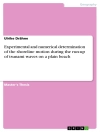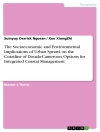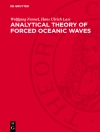This book is a part of ICL new book series “ICL Contribution to Landslide Disaster Risk Reduction” founded in 2019. Peer-reviewed papers submitted to the Fifth World Landslide Forum were published in six volumes of this book series. This book contains the followings:
• Four Forum lectures and one award paper
• Sendai Landslide Partnerships, Kyoto Landslide Commitment, and International Programme on Landslides.
• Landslide-induced tsunamis
• Landslides at UNESCO designates sites and contribution from WMO, FAO, and IRDR
• Education and Capacity Development for Risk Management and Risk Governance
Prof. Kyoji Sassa is the Founding President and the Secretary-General of International Consortium on Landslides (ICL). He has been the Editor-in-Chief of International Journal Landslides since its foundation in 2004.
Prof. Matjaž Mikoš is the Vice President of International Consortium on Landslides and Vice President of Slovenian Academyof Engineering. He is a Professor and Dean of Faculty of Civil and Geodetic Engineering, University of Ljubljana, Slovenia.
Dr. Shinji Sassa is Head of Soil Dynamics Group and Research Director of International Research Center for Coastal Disasters, Port and Airport Research Institute, National Institute of Maritime, Port and Aviation Technology, Japan.
Prof. Peter Bobrowsky is the President of International Consortium on Landslides. He is a Senior Scientist of Geological Survey of Canada, Ottawa, Canada.
Prof. Kaoru Takara is the Executive Director of International Consortium on Landslides. He is a Professor and Dean of Graduate School of Advanced Integrated Studies (GSAIS) in Human Survivability (Shishu-Kan), Kyoto University.
Dr. Khang Dang is the Secretary General of the Fifth World Landslide Forum. He also serves as the Research Promotion Officer of ICL and a Lecturer at the University of Science, Vietnam National University, Hanoi.
Innehållsförteckning
Forum Lectures and Special Lecture: On the prediction of landslides and their consequences.- Design recommendations for single and dual rigid debris flow barriers with and without basal clearance.- The rockfall failure hazard assessment: summary and new advances.- Progress and lessons learned from responses to landslide disasters.- Behind-the-scenes in mitigation of landslides and other geohazards in low income countries – in memory of Hiroshi Fukuoka.- The impact of climate change on landslide hazard and risk.- Sendai Landslide Partnerships, Kyoto Landslide Commitment, and International programme on Landslides: Kyoto 2020 Commitment for Global Promotion of Understanding and Reducing Landslide Disaster Risk.- International Consortium on Landslides.- The ICL journal Landslides – 16 years of capacity development for landslide risk reduction.- UNESCO/KU/ICL UNITWIN Cooperation Programme-Members and recent activities.- International Programme on Landslides (IPL).- SATREPS project for Sri Lanka with regard to “Development of early warning technology of Rain-induced Rapid and Long-travelling Landslides”.- Central Asia – rockslides’ and rock avalanches’ treasury and workbook.- Results of recent monitoring activities on landslide Umka, Belgrade, Serbia – IPL 181.- Landslides in Weathered Flysch: From Activation to Deposition (WCo E 2017-2020).- Report of the Croatian WCo E 2017-2020: From landslide mapping to risk assessment.- LARAM School: an ongoing experience.- Advanced technologies for Landslides (WCo E 2017-2020).- Extreme rainfall event and its aftermath analysis – IPL 210 project progress report.- Complex geomorphological and engineering geological research of landslides with adverse societal impacts.- Report of the IPL-219, IPL-220 and Croatian WCo E 2017-2020: From landslide investigation to landslide prediction and stabilization.- Landslide-induced Tsunamis: Simulation of Tsunami waves induced by coastal and submarine landslides in Japan.- On the use of statistical analysis to understand submarine landslide processes and assess their hazard.- The continuing underestimated tsunami hazard from submarine landslides.- December 11, 2018 landslide and 90-m icy tsunami in the Bureya water reservoir.- The link between upper-slope submarine landslides and mass transport deposits in the hadal trenchs.- Tsunami from the San Andrés Landslide on El Hierro, Canary Islands: first attempt using simple scenario.- A sedimentological study of turbidite layers on a deep–sea terrace in the Japan Trench.- Flank failure of the volcanic Turtle Island and the submarine landslide in the southernmost Okinawa Trough.- Numerical simulation for tsunami generation due to a landslide.- Dealing with mass flow-induced tsunamis at Stromboli volcano: monitoring strategies through multi-platform remote sensing.- Detailed seafloor observation on a deep-sea terrace along the Japan Trench after the 2011 Tohoku Earthquake.- Landslides at UNESCO designates sites and contribution from WMO, FAO, IRDR.- Landslides at UNESCO-designated sites.- Traditional knowledge and local expertise in landslide risk mitigation of world heritages sites.- Reconstruction of the slope instability conditions before the 2016 failure in an urbanized district of Florence (Italy), a UNESCO World Heritage Site.- Integrating Kinematic analysis and Infrared Thermography for instability processes assessment in the rupestrian monastery complex of David Gareja (Georgia).- Shallow landslide susceptibility assessment in the High City of Antananarivo (Madagascar).- Thermo-mechanical cliff stability at tomb KV42 in the Valley of the Kings, Egypt.- Collaboration in MHEWS through an Integrated Way: The Great Efforts Contributed by Multi-stakeholder Partnership at National, Regional and International Levels.- Resilient Watershed Management: Landscape Approach to Climate Change and Disaster Risk Reduction.- Integrating DRR into the conservation and management mechanisms of the internationally designated sites– view of IRDR.- Landslide hazard and risk assessment for civil protection early response.- Size matters: the impact of small, medium and large landslide disasters.- Practices of Public Participation Early Warning System for Geological Hazards in China.- Education and Capacity Development for Risk Management and Risk Governance.- Early warning systems in Italy: state-of-the-art and future trends.- Community-based landslide risk management in contrasting social environments, cases from the Czech Republic.- Refinement Progresses on Freeway Slope Maintenance after a Huge Landslide Disaster.- Landslide exposure community-based mapping: a first encounter in a small rural locality of Mexico.- Co-producing data and decision support tools to reduce landslide risk in the humid tropics.- ICT-based landslide disaster simulation drill: Road to achieve 2030 global commitment.- A Preliminary Work of Safety Potential Analysis Model for Anchors Used on Freeway Slopes.- Initial Experiences of Community Involvement in an Early Warning System in Informal Settlements in Medellín, Colombia.- Capacity Building and Community Preparedness towards Landslide Disaster in Pagerharjo Village, Kulon Progo Regency of Yogyakarta, Indonesia.- Protection of a cultural heritage site in Croatia from rockfall occurrences.- Cutting-edge technologies aiming for better outcomes of landslide disaster mitigation.












